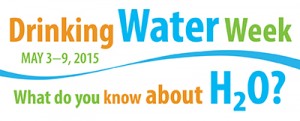Help us celebrate National Drinking Water Week!
May 6, 2015Join us as we celebrate our most important natural resource: clean drinking water.
“Drinking Water Week is an important time to understand our drinking water – from source to tap,” says American Water Works Association Chief  Executive Officer David LaFrance. “To understand the process is to truly appreciate the hard work and dedication that goes into ensuring it’s safe and distributed to millions.”
Executive Officer David LaFrance. “To understand the process is to truly appreciate the hard work and dedication that goes into ensuring it’s safe and distributed to millions.”
Of all the Earth’s water, the majority (97 percent) is found in the ocean or sea. About two percent of the world’s water is frozen. What’s left that’s suitable to use is a little less than one percent.
Every day, millions of us turn on our faucets, but we give little thought to the water that comes out. Do you know how water get from its initial source to your tap? Do you know which federal organizations regulate and set the laws to protect our drinking water?
Many of the improvements in the health, prosperity, and longevity of the U.S. population over the last 100 years can be attributed to improvements in water quality. Water treatment and disinfection have made U.S. tap water one of the safest and healthiest drinking water supplies in the world.
In 1908, Jersey City, N.J. became the first U.S. city to begin routine disinfection of a municipal drinking water supply. Over the next decade, thousands of cities and towns across the United States followed suit, leading to a dramatic decrease in cases of waterborne illness and death.
For example, according to the CDC, in 1900 there were approximately 100 cases of typhoid fever for every 100,000 persons living in the United States. In 2006, the rate had declined to 0.1 cases for every 100,000 persons (only 353 cases of illness in total) and approximately 75 percent — or 265 of those cases — occurred among international travelers.
To learn more about drinking water, click here to watch a virtual tour, provided by the EPA, that explains how a water treatment plant works. It can be viewed in English and Spanish. The link will open up a large file that may take several minutes to open based on your internet connection speed.
You can also click here to print out a coloring page to help teach children about their drinking water.
Take a moment to learn about the water you drink — and take time to protect and conserve our supply of precious drinking water!